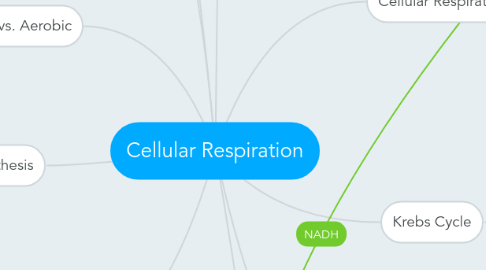
1. Electron Transport Chain
1.1. In the Electron Transport Chain, electrons pass through a series of proteins that build up H+ ions which move through ATP Synthase to change ADP into ATP.
1.1.1. When H+ ions move back into the matrix, through the ATP Synthase, it causes it to spin. When this happens, ADP turns into ATP.
1.2. Produces lots of a ATP by converting ADP into ATP.
1.3. Electrons move from NADH and FADH2 and reduce the oxygen.
1.3.1. NADH starts at a high energy state and moves to a low energy state, H2O.
1.3.2. As the electrons reduce the oxygen, they release energy.
1.3.2.1. The energy is used to move H+ ions (hydrogen) from the matrix into the outer compartment of the mitochondria through the protein complexes.
1.4. This all happens in protein complexes in the inner membrane of the mitochondria.
1.5. NADH and FA
2. Calories
2.1. Unit of energy from food
2.2. 1 calorie raises the temp. of 1 gram of water by 1 degree.
2.3. Our food labels measure things in kilocalories (1000x)
2.4. Fats have 2x the amount of energy per gram then carbohydrates and proteins.
2.5. All of our energy that we need comes in the form of calories.
2.5.1. The original source of calories comes from plants (autotrophs) = sunlight
3. Photosynthesis
3.1. Photosynthesis and cellular respiration provide ingredient needed for each other.
3.2. Photosynthesis generates sugars and oxygen while cellular respiration generates water and carbon dioxide.
4. Anaerobic vs. Aerobic
4.1. Aerobic - with air
4.2. Anaerobic - without air
4.3. Both happen in cellular respiration
5. Fermantation
5.1. Fermentation occurs when there is no oxygen, which makes it anaerobic.
5.2. Lactic Acid Fermentation
5.2.1. Pyruvate + NADH = Lactic Acid and NAD+
5.2.2. Requires Oxygen later to break down Lactic acid to build up.
5.2.3. Supplies quick energy
5.3. Alcoholic Fermentation
5.3.1. Pyruvate + NADH = Alcohol + CO2 + NAD
5.3.2. Yeasts and a few other microganisms
5.3.3. This process is carried out by yeast which are essential for making bread rise (CO2) and producing alcoholic beverages (alcohol).
6. Glucose
6.1. "Most of what we eat ends up as glucose." Hank Green.
6.2. Glucose goes into glycolysis and becomes pyruvic acid. It is food molecule and a simple sugar.
6.3. Glycolysis produces 2 ATP molecules per molecule of glucose.
6.4. All together, all the cycles produce 36 molecules of ATP per 1 molecule of glucose.
7. Oxidation vs. Reduction
7.1. Oxidation is losing of electrons
7.2. Reduction is gaining electrons
8. Glycolysis
8.1. Glycolysis creates pyruvate (3 carbon chain) and small amounts of ATP and NADH. All these reactions happen in the cytoplasm,or the empty space inside the cell.
8.1.1. ATP - ATP is the energy released during glycolisis because of the oxidation reactions.
8.1.2. Glucose - Glycolisis starts with 6-carbon glucose. In the first steps of glycolisis, two phosphates are added to the glucose molecule, which costs two molecules of ATP.
8.1.3. The end result is 2 ADP molecules and a 6-carbon sugar diphosphate molecule.
8.1.4. The 6-carbon sugar diphosphate molecule is then split into 2 3-carbon molecules
8.1.5. The 2 3-carbon molecules are then converted into 2 3-carbon pyruvate
8.1.5.1. During this, 4 electrons are passed to NAD+ to produce NADH. While NAD+ is carrying the 4 electrons to the Electron Transport Chain, it is called NADH.
8.1.5.1.1. So, NAD+ is called a electron carrier.
8.1.5.2. Also during this reaction, the cell is gaining energy, because ADP turns into ATP (?).
8.1.6. After all of this happens, NADH goes to the Electron Transport Chain. 2 pyruvic acid 3-carbon molecules are left over. They go to the Krebs Cycle.
8.2. Glycolisis does not require oxygen. (anaerobic)
9. Krebs Cycle
9.1. "During the Krebs Cycle, pyruvic acid is broken down into carbon dioxide in a series of energy-extracting reactions." quoted from science book.
9.1.1. 1st, the pyruvic acid from glycolisis, enters the matrix, with inside the mitochondria.
9.1.1.1. Mitochondria are in the cytoplasm in the cell.
9.1.2. 2nd, 1 carbon atom from pyruvic acid, joins with 1 molecule of carbon dioxide.
9.1.2.1. Eventually, these molecules go into the air.
9.1.3. 3rd, the other 2 carbon atoms of pyruvic acid, go and form acetic acid. Coenzyme A joins them so that makes acetyl-CoA.
9.1.4. 4th, 4 carbon molecules joins the 2 carbon molecule Acetyl-CoA, so now there are 6 carbon molecules.
9.1.5. ADP in converted in ATP
9.2. The Krebs Cycle produces carbon dioxide, NADH, ATP, and FADH2.
9.3. The Krebs Cycle has to happen twice, becuase there are 2 molecules of pyruvic acid.
9.4. Uses pyruvic acid to generate NADH, FADH2, CO2, and ATP.
10. Cellular Respiration
10.1. A three stage process that releases energy trapped in food (Carbs, protein, fat) when combined with O2.
10.1.1. The three stages are Glycolysis, Krebs cycle, and Electron Transport Chain.
